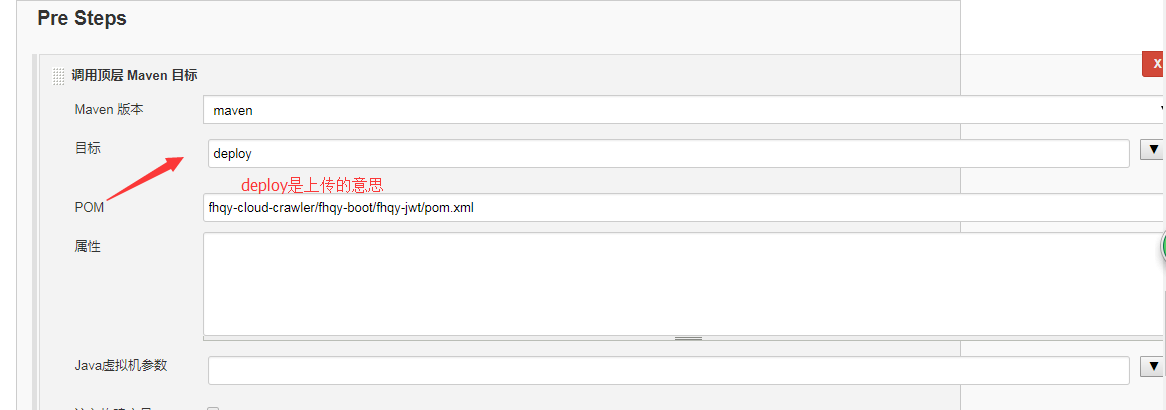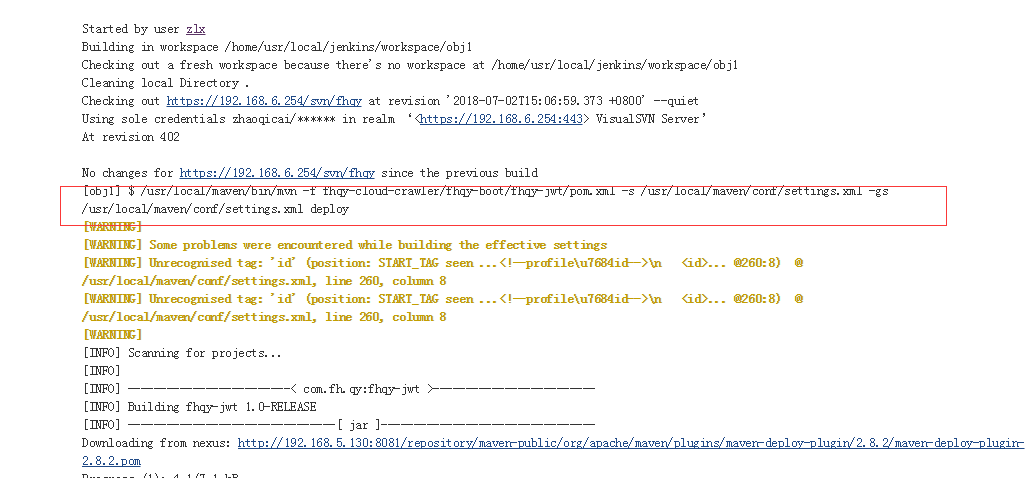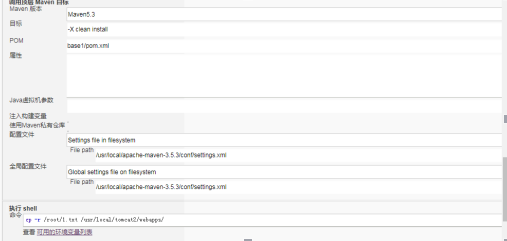jenkins 自动上传代码到nexus 私库
1.jenkins 项目配置上传


2.jenkins 访问私库下载配置
-X clean install

3.maven 配置文件
/usr/local/maven/conf/settings.xml
<?xml version="1.0" encoding="UTF-8"?>
<!--
Licensed to the Apache Software Foundation (ASF) under one
or more contributor license agreements. See the NOTICE file
distributed with this work for additional information
regarding copyright ownership. The ASF licenses this file
to you under the Apache License, Version 2.0 (the
"License"); you may not use this file except in compliance
with the License. You may obtain a copy of the License at
http://www.apache.org/licenses/LICENSE-2.0
Unless required by applicable law or agreed to in writing,
software distributed under the License is distributed on an
"AS IS" BASIS, WITHOUT WARRANTIES OR CONDITIONS OF ANY
KIND, either express or implied. See the License for the
specific language governing permissions and limitations
under the License.
-->
<!--
| This is the configuration file for Maven. It can be specified at two levels:
|
| 1. User Level. This settings.xml file provides configuration for a single user,
| and is normally provided in ${user.home}/.m2/settings.xml.
|
| NOTE: This location can be overridden with the CLI option:
|
| -s /path/to/user/settings.xml
|
| 2. Global Level. This settings.xml file provides configuration for all Maven
| users on a machine (assuming they're all using the same Maven
| installation). It's normally provided in
| ${maven.conf}/settings.xml.
|
| NOTE: This location can be overridden with the CLI option:
|
| -gs /path/to/global/settings.xml
|
| The sections in this sample file are intended to give you a running start at
| getting the most out of your Maven installation. Where appropriate, the default
| values (values used when the setting is not specified) are provided.
|
|-->
<settings xmlns="http://maven.apache.org/SETTINGS/1.0.0"
xmlns:xsi="http://www.w3.org/2001/XMLSchema-instance"
xsi:schemaLocation="http://maven.apache.org/SETTINGS/1.0.0 http://maven.apache.org/xsd/settings-1.0.0.xsd">
<!-- localRepository
| The path to the local repository maven will use to store artifacts.
|
| Default: ${user.home}/.m2/repository
<localRepository>/path/to/local/repo</localRepository>
-->
<!-- interactiveMode
| This will determine whether maven prompts you when it needs input. If set to false,
| maven will use a sensible default value, perhaps based on some other setting, for
| the parameter in question.
|
| Default: true
<interactiveMode>true</interactiveMode>
-->
<!-- offline
| Determines whether maven should attempt to connect to the network when executing a build.
| This will have an effect on artifact downloads, artifact deployment, and others.
|
| Default: false
<offline>false</offline>
-->
<!-- pluginGroups
| This is a list of additional group identifiers that will be searched when resolving plugins by their prefix, i.e.
| when invoking a command line like "mvn prefix:goal". Maven will automatically add the group identifiers
| "org.apache.maven.plugins" and "org.codehaus.mojo" if these are not already contained in the list.
|-->
<pluginGroups>
<!-- pluginGroup
| Specifies a further group identifier to use for plugin lookup.
<pluginGroup>com.your.plugins</pluginGroup>
-->
</pluginGroups>
<!-- proxies
| This is a list of proxies which can be used on this machine to connect to the network.
| Unless otherwise specified (by system property or command-line switch), the first proxy
| specification in this list marked as active will be used.
|-->
<proxies>
<!-- proxy
| Specification for one proxy, to be used in connecting to the network.
|
<proxy>
<id>optional</id>
<active>true</active>
<protocol>http</protocol>
<username>proxyuser</username>
<password>proxypass</password>
<host>proxy.host.net</host>
<port>80</port>
<nonProxyHosts>local.net|some.host.com</nonProxyHosts>
</proxy>
-->
</proxies>
<!-- servers
| This is a list of authentication profiles, keyed by the server-id used within the system.
| Authentication profiles can be used whenever maven must make a connection to a remote server.
|-->
<servers>
<!-- server
| Specifies the authentication information to use when connecting to a particular server, identified by
| a unique name within the system (referred to by the 'id' attribute below).
|
| NOTE: You should either specify username/password OR privateKey/passphrase, since these pairings are
| used together.
|
-->
<server>
<id>releases</id>
<username>admin</username>
<password>admin123</password>
</server>
<server>
<id>snapshots</id>
<username>admin</username>
<password>admin123</password>
</server>
<!-- Another sample, using keys to authenticate.
<server>
<id>siteServer</id>
<privateKey>/path/to/private/key</privateKey>
<passphrase>optional; leave empty if not used.</passphrase>
</server>
-->
</servers>
<!-- mirrors
| This is a list of mirrors to be used in downloading artifacts from remote repositories.
|
| It works like this: a POM may declare a repository to use in resolving certain artifacts.
| However, this repository may have problems with heavy traffic at times, so people have mirrored
| it to several places.
|
| That repository definition will have a unique id, so we can create a mirror reference for that
| repository, to be used as an alternate download site. The mirror site will be the preferred
| server for that repository.
|-->
<mirrors>
<!-- mirror
| Specifies a repository mirror site to use instead of a given repository. The repository that
| this mirror serves has an ID that matches the mirrorOf element of this mirror. IDs are used
| for inheritance and direct lookup purposes, and must be unique across the set of mirrors.
|
<mirror>
<id>mirrorId</id>
<mirrorOf>repositoryId</mirrorOf>
<name>Human Readable Name for this Mirror.</name>
<url>http://my.repository.com/repo/path</url>
</mirror>
-->
<mirror>
<id>nexus</id>
<name>internal nexus repository</name>
<url>http://192.168.5.130:8081/repository/maven-public/</url>
<mirrorOf>*</mirrorOf>
</mirror>
</mirrors>
<!-- profiles
| This is a list of profiles which can be activated in a variety of ways, and which can modify
| the build process. Profiles provided in the settings.xml are intended to provide local machine-
| specific paths and repository locations which allow the build to work in the local environment.
|
| For example, if you have an integration testing plugin - like cactus - that needs to know where
| your Tomcat instance is installed, you can provide a variable here such that the variable is
| dereferenced during the build process to configure the cactus plugin.
|
| As noted above, profiles can be activated in a variety of ways. One way - the activeProfiles
| section of this document (settings.xml) - will be discussed later. Another way essentially
| relies on the detection of a system property, either matching a particular value for the property,
| or merely testing its existence. Profiles can also be activated by JDK version prefix, where a
| value of '1.4' might activate a profile when the build is executed on a JDK version of '1.4.2_07'.
| Finally, the list of active profiles can be specified directly from the command line.
|
| NOTE: For profiles defined in the settings.xml, you are restricted to specifying only artifact
| repositories, plugin repositories, and free-form properties to be used as configuration
| variables for plugins in the POM.
|
|-->
<profiles>
<!-- profile
| Specifies a set of introductions to the build process, to be activated using one or more of the
| mechanisms described above. For inheritance purposes, and to activate profiles via <activatedProfiles/>
| or the command line, profiles have to have an ID that is unique.
|
| An encouraged best practice for profile identification is to use a consistent naming convention
| for profiles, such as 'env-dev', 'env-test', 'env-production', 'user-jdcasey', 'user-brett', etc.
| This will make it more intuitive to understand what the set of introduced profiles is attempting
| to accomplish, particularly when you only have a list of profile id's for debug.
|
| This profile example uses the JDK version to trigger activation, and provides a JDK-specific repo.
<profile>
<id>jdk-1.8</id>
<activation>
<jdk>1.8</jdk>
</activation>
<repositories>
<repository>
<id>jdk14</id>
<name>Repository for JDK 1.4 builds</name>
<url>http://www.myhost.com/maven/jdk14</url>
<layout>default</layout>
<snapshotPolicy>always</snapshotPolicy>
</repository>
</repositories>
</profile>
-->
<!--
| Here is another profile, activated by the system property 'target-env' with a value of 'dev',
| which provides a specific path to the Tomcat instance. To use this, your plugin configuration
| might hypothetically look like:
|
| ...
| <plugin>
| <groupId>org.myco.myplugins</groupId>
| <artifactId>myplugin</artifactId>
|
| <configuration>
| <tomcatLocation>${tomcatPath}</tomcatLocation>
| </configuration>
| </plugin>
| ...
|
| NOTE: If you just wanted to inject this configuration whenever someone set 'target-env' to
| anything, you could just leave off the <value/> inside the activation-property.
|
<profile>
<id>env-dev</id>
<activation>
<property>
<name>target-env</name>
<value>dev</value>
</property>
</activation>
<properties>
<tomcatPath>/path/to/tomcat/instance</tomcatPath>
</properties>
</profile>
-->
<!--profile的id-->
<id>dev</id>
<repositories>
<repository>
<!--仓库id,repositories可以配置多个仓库,保证id不重复-->
<id>nexus</id>
<!--仓库地址,即nexus仓库组的地址-->
<url>http://192.168.5.130:8081/repository/maven-releases/</url>
<!--是否下载releases构件-->
<releases>
<enabled>true</enabled>
</releases>
<!--是否下载snapshots构件-->
<snapshots>
<enabled>true</enabled>
</snapshots>
</repository>
</repositories>
<pluginRepositories>
<!-- 插件仓库,maven的运行依赖插件,也需要从私服下载插件 -->
<pluginRepository>
<!-- 插件仓库的id不允许重复,如果重复后边配置会覆盖前边 -->
<id>public</id>
<name>Public Repositories</name>
<url>http://192.168.5.130:8081/repository/maven-snapshots/</url>
</pluginRepository>
</pluginRepositories>
</profiles>
<!-- activeProfiles
| List of profiles that are active for all builds.
|
<activeProfiles>
<activeProfile>alwaysActiveProfile</activeProfile>
<activeProfile>anotherAlwaysActiveProfile</activeProfile>
</activeProfiles>
-->
</settings>
jenkins 自动上传代码到nexus 私库的更多相关文章
- Maven 如何发布 jar 包到 Nexus 私库
Nexus2可以通过管理界面来上传jar包到私库中,而最新的Nexus3却找不到了上传界面,只能通过以下方式来发布到私库. 发布第三方jar包 这种情况是maven远程仓库没有,本地有的第三方jar包 ...
- Maven如何发布jar包到Nexus私库
Nexus2可以通过管理界面来上传jar包到私库中,而最新的Nexus3却找不到了上传界面,只能通过以下方式来发布到私库. 发布第三方jar包 这种情况是maven远程仓库没有,本地有的第三方jar包 ...
- maevn的nexus私库搭建
使用nexus搭建maven仓库(本地私服) 前言:我们在使用maven的时候,对于项目所依赖的jar包,maven默认会在中央仓库下载jar包,到本地的磁盘目录(如果没有配置则是用户目录下/.m2/ ...
- Easypack容器系列之:Nexus 3:Docker私库
Nexus作为私库管理最为流行的工具之中的一个,用于包的管理和Docker镜像管理的私库管理场景中非经常常使用.Easypack利用最新版本号的oss版Nexus作为基础镜像用于提供相似服务. 本文将 ...
- DevOps - 项目私库 - Nexus Repository
相关链接 Sonatype官网:https://www.sonatype.com Products: Nexus Repository OSS2.x & 3.x Documentation: ...
- Docker 容器中搭建 nexus npm私库
1,版本 dockers :1.13.1 :nexus 3 2,安装 docker pull liumiaocn/nexus 3,启动 项目 详细 Nexus UI 8081 private re ...
- maven私库nexus2.11.4迁移升级到nexus3.12.0
nexus简介 nexus是一个强大的maven仓库管理器,它极大的简化了本地内部仓库的维护和外部仓库的访问. nexus是一套开箱即用的系统不需要数据库,它使用文件系统加Lucene来组织数据 .n ...
- maven&nexus_repository 私库搭建与使用
一.nexus仓库安装 1,http://www.sonatype.org/nexus/ 下载sso版本,免费2,tar -zxvf nexus-2.11.1-01-bundle.tar.gz3 ...
- nexus3.14.0版本linux环境安装、启动、搭建私库
本文介绍的是nexus3.14.0版本在linux环境下安装.启动.搭建私库. nexus3以上的版本太新了,网上很少介绍安装细节的.据了解和2.X版本有所不同了. 1.前提 linux机器上需先安装 ...
随机推荐
- 一、TCL事务控制语言 二、MySQL中的约束 三、多表查询(重点) 四、用户的创建和授权 五、MySQL中的索引
一.TCL事务控制语言###<1>事务的概念 事务是访问并可能更新数据库中各种数据项的执行单元. 事务是一条SQL语句,一组SQL语句,或者整个程序. 事务是恢复和并发控制的基本单位. 事 ...
- 装office系统软件
在电脑里搜索 SW_DVD5_Office_Professional_Plus_2010w_SP1_64Bit_ChnSimp_CORE_MLF_X17-76742 如果已经安装过了,有错误,直接进行 ...
- 面向对象课程 - 寒假第三次作业 - C++计算器项目初始部分
C++计算器项目初始部分 零.项目源文件地址 传送门:calculator 一.项目信息相关: 项目:Calculator 版本:1.0 日期:2016.2.16 实现: 基本的操作界面 对四则运算表 ...
- Mina使用总结(二)Handler
Handler的基本作用,处理接收到的客户端信息 一个简单的Handler实现如下: package com.bypay.mina.handler; import java.util.Date; im ...
- HTML5的新标签-整体布局
过去:<div class="header"> <div class="hgroup"> <h1>....</h1&g ...
- echarts问题
1.鼠标经过折线图 显示的框中的文字设置,需要设置tooltip下的formatter属性 formatter属性值可以为字符串也可function formatter:function(data) ...
- 论文笔记 Pose-driven Deep Convolutional Model for Person Re-identification_tianqi_2017_ICCV
1. 摘要 为解决姿态变化的问题,作者提出Pose-driven-deep convolutional model(PDC),结合了global feature跟local feature, 而loc ...
- Eclipse开发工具常用快捷键的使用技巧
Eclipse作为软件开发的常用工具,被很多的人所欢迎,尤其是丰富的快捷键,可以极大的提高编码的效率,下面将常用的快捷键做了整理,便于大家学习和使用. Eclipse常用快捷键 1代码提示 Alt ...
- 六、Delphi10.3通过Json.Serializers单元对大量数据序列化
一.参考我之前的博客,Delphi可以很方便的把类和结构体转换成JSON数据,但是数据量大了,就会非常之慢,1万条数据需要20秒左右.如果引用Serializers单元,那么100万数据只需要4秒左右 ...
- Scrapy-从数据库取出IP并判断是否可用
import pymysql import requests conn = pymysql.connect(host="localhost",user="root&quo ...
